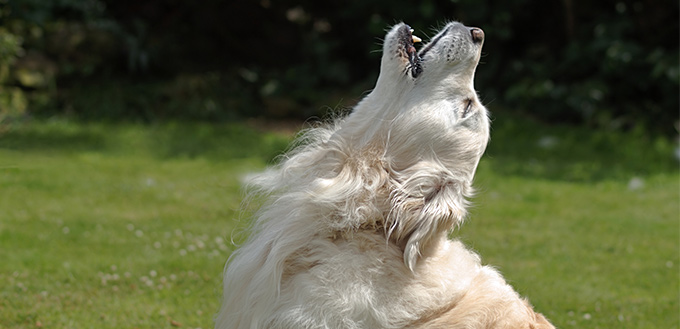Barking is a completely normal behavior for all canines. A little bark here and there is to be expected from pretty much all pet dogs, as through barking our furry companions express what they want and currently think and feel. But there is such a thing as excessive barking, and we’ve all heard it– walking past a house and hearing the dog inside explode into loud, aggressive barking is annoying and slightly terrifying for the person walking by, but can you imagine what it’s like for the owner of that dog? Having a pet that barks loudly at every person that walks by the house can be headache-inducing. If you’re that owner – we feel you. It can be really hard to train your dog to bark less. Luckily, we know a trick or two that can help you teach your pet how to behave more politely.

Why do Dogs Bark?
To learn how to teach your dog to bark less or completely stop barking unless the situation calls for it (say, someone breaking into your house!), you need to understand why dogs bark in the first place. Obviously, all dogs are different and they may bark for different reasons, but the following ones are the most common:
- Territorial barking
It’s no secret that dogs, like most animals, are territorial creatures. Usually, they don’t like when a person or an animal they don’t know comes into their territory, whether that’s a house, an apartment – or even a whole street. Sometimes, a dog will bark not for himself but for his owner or family – if they perceive a person as dangerous, they’ll bark non-stop in order to warn you (by the way, the person may not actually be dangerous in any way, your dog may just not like them!).
Territorial barking looks and sounds aggressive – usually, it’s a continuous string of barks at a lower pitch than usual. The posture of a dog will reflect this too, as the tail will usually be held high while the ears will be up and forward.
- Alarmed barking
Dogs are pack animals and when they get alarmed by something or someone, they like to bark to alert their “pack” that there’s something suspicious going on. This may be something they perceive as dangerous, threatening or just curious. This can happen literally anywhere, not just in their territory.
This type of barking is the most common form of barking and usually happens in rapid strings – two to four barks with short pauses in between.
- Lonely barking
Dogs are social animals who need regular interaction either with their human family or other pets. Canines left alone for long periods of time can become very lonely, and as a result, will bark or howl to express their unhappiness. Speaking of unhappy dogs, there is such a thing as separation anxiety in dogs, which is a frantic and often disruptive behavior associated with dog separation from their owners. These dogs may bark incessantly, howl, salivate, pant and pace, and some may try to even destroy items in the home and urinate inside the house when their owners leave.
This form of barking (loneliness) happens in long strings, with deliberate pauses between each bark.
- Attention-seeking barking
If your furry friend barks while looking at you, it’s highly likely she’s trying to ask you to do something. She may want to eat, drink water, take a walk, play or just spend some time with you. While this may seem similar to lonely barking, it’s different in a way because a dog seeking attention will usually bark excitingly.
This type of barking happens in a few sharp, short barks and may sound something like “Harrr-ruff!”.
It’s a good idea to learn to differentiate between different types of barking, just so you can know how to calm down your dog. For example, teaching a dog with anxiety separation to bark less is not going to work until you two get down to the root of the problem and fix it. But training an overly protective dog to bark less? Totally different story and one much, much more likely to have a positive outcome.

Prevent the Barking in Puppies
If you have a puppy that is already showing signs of excessive barking, it’s wise to start working on the problem as soon as possible. Training a dog to bark less is always easier while he’s young – even better, when he is just a tiny puppy.
- Use treats
Positive reinforcement works on pretty much all dogs. If your puppy barks like crazy, try to teach him to be quiet and then give him a treat every time he listens. Start by teaching him Speak/Quiet commands – it will take time, sometimes more than you’d like, but it’s so worth it to teach a dog these basic commands while he’s very young. Every time your puppy listens and stops barking on your command, give him a treat (make sure you buy some good-quality ones though!).
- Stay calm
Usually, dogs don’t respond well to loud, angry voices, so try to stay calm and speak softly when talking to your puppy, even if her barking makes you agitated. If your puppy keeps barking for no apparent reason, he’s probably upset/scared or just overly excited, so try to make it easier for her to relax. Then, try the treat trick – Speak/Quiet commands followed by treats when performed successfully work the best when the puppy is relaxed.
Stop the Barking in Adult Dogs
So prevention is always better than a cure, or in this case, training an adult dog to stop doing things he’s learned to do. But what to do if you have an adult canine who barks non-stop? Is it too late in some cases? Absolutely not – almost all dogs (except for those with neurological disorders) can be trained to bark less. Bear in mind we said less, not stop barking completely – after all, you wouldn’t like it if someone who finds your voice annoying made you stop talking completely, would you?
So how can you train an adult dog to stop barking for the wrong reasons? There are a few different training techniques and simple tricks that could help you. We cover everything in detail down below, so make sure you read it all – pick a technique or a combination of a few that you think would work well on your furry companion and start training him today.
- Remove the motivation
Often, a dog will do a certain activity, such as barking, because she gets some kind of a reward for it. Try to figure out what your pooch gets out of barking and then remove it. If, in the past, you would ‘reward’ your dog by saying “good girl” when she barked at people, objects, situations or whatever really, make sure you stop saying that. If you’ve already stopped, but your pooch keeps excessively barking, try to associate the saying she learned to like with something else – something you find positive.
For instance: teach your dog Speak/Quiet command, and every time she stops barking at something, say “good girl” (or whatever it is you normally say to her) and give her a treat. One of the best training methods is to use treats along with positive words/sayings to reinforce a good behavior. Of course, in order for this to work, your dog should already understand the Speak/Quiet command, and if she doesn’t – we highly, highly encourage you to teach her. Sure, it may take some time for an adult dog to learn a new trick, but rest assured, this will be a time well spent.
This technique works pretty much for all barkers.
Tip: never reward your dog while she’s barking, only when she listens and stays quiet.
- Desensitize your dog to the stimulus
If your hound barks at dogs, cats and certain objects, desensitizing him to that animal or an object can work really well. Gradually get your pooch accustomed to whatever is causing him to bark. The key word here is gradually – start by showing him the subject from afar slowly but consistently. Again, dog treats work like magic here too, so don’t be afraid to use them whenever your dog listens to you.
For instance: if your pet barks at dogs, have a friend and his dog stand far enough away so your pooch can barely see them. As your friend and his dog come closer (slowly!), start feeding your dog treats. Remember, never give a treat while the dog is barking – only before he starts barking, or after he becomes quiet (use the Quiet command). Then, as your friend moves away and starts disappearing from the view, stop feeding treats. This may take several days or even a few weeks to work – but if you’re consistent in your approach, your dog should become desensitized fairly quickly.
This method works best for territorial and alarmed barkers.
- Ignore the barking
When your dog explodes into loud barking, the last thing you want to do is just sit there and ignore it, right? Well, sometimes it’s wise you do just that. Attention-seeking dogs will often bark for no apparent reason but to get some sort of acknowledgment from you. This ties into the “Remove motivation” method – if your dog’s motivation for barking is to get an acknowledgment from you, whether that’s getting up from the couch and coming to him, or talking to him, trying to calm him down, what you want to do is remove that motivation. Attention-seeking dogs are similar to tantrum-causing children. They will try their best to get their way by being loud, stubborn and pushy. Take the power out of your pet’s demanding barking by ignoring him.
For instance: if your pooch barks at you with an agenda, just turn away from him and ignore his barks. If he continues barking, you continue ignoring. He may bark because he wants to play or because he wants you to fetch his ball that’s rolled under the bed – it doesn’t matter if it’s attention-seeking barking. What matters though is that you don’t give in but stay calm and wait for him to stop barking. Then, and only then you can play with him or get his ball or whatever he had in mind. This works like treats work – you reward good behavior and ignore the bad one.

This technique works best for attention-seeking barking or play and frustration-barking.
- Exercise, exercise, exercise
Dogs are playful, active animals who need lots of exercise in order to be healthy, happy, and yes, quiet. Many dogs who bark excessively bark because they’re simply bored out of their mind – they need physical and mental exercise frequently and regularly. You’d be surprised at the number of dogs who could be kept quiet if only they had enough exercise. Of course, this depends on the breed and personality of your pooch (for example, a German Shepherd needs much, much more physical activity than, say, a Bulldog), as some canines are simply more energetic and lively than others.
Tired dogs are less alert than usual, and as a result, less in the mood to bark at every single thing that catches their attention. So take time to wear out your furry friend every single day (or at least every other day if you’re super-busy) with a nice, long walk, or better yet, a jog. Also incorporate a rousing game of tug or fetch and stimulate her brain with mind-teasing games such as “find the toy”.
Although this is not a training technique per se, it works on all barkers.
- Pheromone-based treatments
Pheromone-based treatments can help calm and de-stress your dog, which is helpful if you have a stressed out barker at hands. Dogs that are sad, lonely or just stressed for some reason can greatly benefit from such treatments.
So how does this work? Devices such as plug-in diffusers use pheromones, a type of chemical communication between dogs (and other species) that have a calming effect on stressed-out pets. Basically, these calming chemicals mimic natural dog pheromones and help relieve stressed pets. They are especially useful if you have a dog who suffers from separation anxiety, although they work on any type of stress. This treatment comes in many forms, including plug-in diffusers, sprays, wipes and perhaps the most handy one – collars. If you buy a spray, use it every time your stressed dog starts barking.
This training method is best suited for fear barkers and/or separation distress barkers.
Check out our guide on the Best Calming Treats for Dogs.
Use Bark Collars
Finally, if you have a really, really stubborn dog who won’t stop barking no matter what and how hard you try, use a dog bark collar. There are different types of bark collars on the market, including:
- Static bark collars: highly versatile, these collars work by sending short pulses of static to the dog when its sensors detect barking. Some premium static collars also send interruptive tone warnings or vibrations. They come in all kinds of types and sizes so it’s easy to find the right one for your pooch.
- Vibration bark collars: like the static collars, these collars too have sensors that can detect when the dog starts barking. They send interruptive vibrating pulses when the barking begins, which force the dog to stop. The pulse intensity can be pre-adjusted so you can lower it or make it higher, depending on your pet’s behavior.
- Spray bark collars: these collars are the newest of the bunch, and some may argue the gentlest of them all. Small sensors built in the collar detect when a dog starts barking, and then initiate the delivery of a tiny burst of spray (scented water) near a dog’s snout. The spray is safe for animals and people and is environmentally-friendly.
- Ultrasonic bark collars: using high-pitched sounds that are inaudible to people but audible to dogs, these collars interrupt the barking and calm the dog down. Besides sounds, some ultrasonic collars also use vibration as an added stimulus.
- Shock bark collars: lastly, there are shock collars that can help you train your dog to stop barking. However, these are serious devices that we believe should only be used by experienced canine trainers or dog handlers. These collars can be highly effective, but they should be used only as the last resort – meaning, you should first try every single training technique you can think of before resorting to using a shock collar. So how do these things work? Similarly to the collars described above, these devices have sensors that can detect barking, and when they do, they initiate the shock administration. Of course, approved shock collars deliver shocks that are mild enough to be safe (they can’t physically harm the dog) but are strong enough to make him stop barking. Many such collars also use vibration and/or sounds as warnings before an actual shock is delivered.
Take a look at our article on the best shock collar for dogs.

Helpful Tips and Tricks to Make Your Dog Stop Barking
Now that we’ve covered some of the most important and effective training techniques for bark-control, it’s time we focus on some additional helpful tips and tricks. Use these in addition to one or two main training techniques and you’re pretty much guaranteed to have a calmer dog who barks less.
- Block your dog’s view
If your pup is quite territorial and likes to bark whenever she sees a stranger walking by, it’s a good idea to block her view out the window (or wherever she sees strangers passing by). By cutting her exposure to the sights, sounds or smells that incite her, you’ll calm her down and stop excessive barking. Just close the blinds, or better yet, install a temporary privacy window film. Place it above your pet’s line of sight, and then, once she gets used to it and seems less interested in staring out the window, slowly start lowering it down – inch by inch. After a few days or a couple of weeks, your furry buddy should become used to seeing strangers without exploding into loud barking.
This trick is helpful for territorial and alarm barkers.
- Use interactive dog toys
Many dogs, but especially bored, lonely and attention-seeking dogs, can benefit greatly from having something to do when their human family leaves the house. Busy or interactive toys are perfect for these canines. Things such as hard rubber toys, dog puzzle toys and treat-dispensing toys can keep your pooch engaged, entertained and busy enough to forget to bark. For example, if your pet barks at you whenever you start talking on your phone, throw her a toy like this the next time you make calls.
You May Also Like: Automatic Fetch Machines
This is helpful for attention-seeking barkers, lonely and bored dogs.
- Use white noise machines
If your pooch is jumpy and quite territorial, he’s probably barking at every single thing that seems out of the ordinary. “Strange car noise? Better bark to alert my human parent. Unknown voices talking outside the apartment? Better growl and bark to let them know who lives here.” This is pretty much how all overly territorial dogs think, so it can be hard to train them to bark less as everything unusual is seen as a threat. To help your dog relax a little, you can try using white machine noise – a device like this makes steady, unchanging sound that can camouflage outside noises. It’s an easy and simple way to cover incidental voices/noises and as a result, make your pet a bit more relaxed.
This trick works best for territorial and alarm barkers, although it may also help stressed canines as well.
Final tip: remember that training a dog takes time, patience and consistency. After all, even humans need some time to learn a new skill, and dogs and no different in this manner. If your canine buddy has been an excessive barker for a long time, it will take longer to teach him the new ways than it would if he was just a puppy showing signs of excessive barking.
So take your time and arm yourself with patience – be gentle but firm with your pet when training him to bark less. Try one training method and if it doesn’t work, try another one, and if that one doesn’t work, try another one. Like humans, dogs are all different and what works great for your friend’s dog may not work for yours. Experiment, stay focused and don’t give up – it’s never too late to teach an (old) dog a new trick!
Sources:
- Stanley Coren PhD, What Are Dogs Trying to Say When They Bark?, PsychologyToday
- How to Get Your Dog to Stop Barking, HumaneSociety
- Dr. Teresa Manucy, How to Stop a Dog From Barking, PetMD







